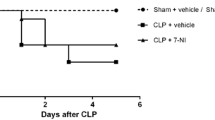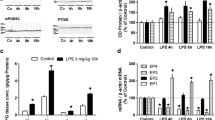Abstract
We tested the hypothesis that nitric oxide (NO) arising from the action of inducible nitric oxide synthase (iNOS) is responsible for the deficiency in vasopressin (AVP) release and consequent hypotension during endotoxaemic shock. Wild-type (WT) and iNOS knockout mice (iNOS−/−) were given either saline or Escherichia coli lipopolysaccharide (LPS, 1.0 mg/kg i.v., final volume 0.03 ml). Mean arterial blood pressure (MAP) was measured and plasma AVP levels determined before and after LPS or saline injection. In WT mice, MAP was significantly lower 2 h after LPS administration and remained low for the remainder of the 6-h observation period. AVP plasma levels were increased at the 2nd and 4th h of the experiment, returning thereafter to basal levels. Conversely, LPS injection in iNOS iNOS−/− mice elicited a sustained increase in plasma AVP concentration and attenuated the fall in blood pressure. These data indicate that NO arising from the iNOS plays an important inhibitory role in AVP release during endotoxaemia and may be responsible for the hypotension occurring during this vasodilatory shock.



Similar content being viewed by others
References
Brosnan CF, Lee SC, Liu J (1997) Regulation of inducible nitric oxide synthase expression in human glia: implications for inflammatory central nervous system diseases. Biochem Soc Trans 25:679–683
Gaston B, Drazen JM, Loscalzo J (1994) The biology of nitrogen oxides in the airways. Am J Resp Crit Care Med 149:538–551
Gazzinelli RT, TI Eltoum, TA Wynn (1993) Acute cerebral toxoplasmosis is induced by in vivo neutralization of TNF-α and correlates with the down-regulated expression of inducible nitric oxide synthase and other markers of macrophage activation. J Immunol 151:3672–3681
Giusti-Paiva A, Branco LG, De Castro M, Antunes-Rodrigues J, Cárnio EC (2003) Role of the nitric oxide in thermoregulation during septic shock: involvement of vasopressin. Pflugers Arch 447:175–180
Giusti-Paiva A, De Castro M, Antunes-Rodrigues J, Carnio EC (2002) Inducible nitric oxide synthase in the central nervous system and vasopressin release during experimental septic shock. Crit Care Med 30:1306–1309
Groover R, Lopes A, Lorente J (1997) Multicenter, randomized, placebo-controlled, double-blinded study of the nitric oxide synthase inhibitor 546C88: Effect on survival in patients with septic shock. Crit Care Med 27(Suppl I):A33
Holmes CL, Patel B, Russell JA (2001) Physiology of vasopressin relevant to management of septic shock. Chest 120:989–1002
Holmes CL, Russell JA, Walley KR (2000) Sepsis: is there room for vasopressin?. Sepsis 4:169–175
Kadekaro M, Terrell ML, Liu H (1998) Effects of L-NAME on cerebral metabolic, vasopressin, oxytocin, and blood pressure in haemorrhage rats. Am J Physiol 274:R1070–R1077
Kjeldsen TH, Rivier C, Lee S (2003) Inducible nitric oxide synthase is responsible for nitric oxide release from murine pituicytes. J Neuroendocrinol 15:250–255
Landry DW, Levin HR, Gallant EM (1997) Vasopressin deficiency contributes to the vasodilation of septic shock. Circulation 95:1122–1125
Lopez A, Lorente JA, Steingrub J (2004) Multiple-center, randomized, placebo-controlled, double-blind study of the nitric oxide synthase inhibitor 546C88: effect on survival in patients with septic shock. Crit Care Med 32:21–30
Malay MB, Ashton RC, Landry DW (1999) Low-dose vasopressin in the treatment of vasodilatory septic shock. J Trauma 47:699–705
Maliszewski CR (1991) CD14 and immune response to lipopolysaccharide. Science 252:1321–1322
Mancuso C, Ragazzoni E, Tringali G, Liberali I, Preziozi P, Grossman A, Navarra P (1999) Inhibition of heme oxygenase in the central nervous system potentiates endotoxin-induced vasopressin release in the rat. J Neuroimmunol 29:189–94
Mattson DL, Krauski KR (1998) Chronic sodium balance and blood pressure response to captopril in conscious mice. Hypertension 32:923–928
Morrison DC, Ryan JL (1997) Endotoxin and disease mechanisms. Annu Rev Med 38:417–432
Ota M, Crofton JT, Festavan GT (1993) Evidence that nitric oxide can act centrally to stimulate vasopressin release. Neuroendocrinology 57:955–959
Parrillo JE, Parker MM, Natanson C (1990) Septic shock in humans: advances in the understanding of pathogenesis, cardiovascular dysfunction, and therapy. Ann Intern Med 113:227–242
Pfeffer K, Matsuyama T, Kündig TM (1993) Mice deficient for 55kd tumor necrosis factor receptor are resistant to endotoxic shock, yet succumb to L. monocytogenes infection. Cell 73:457–467
Rietschel ET, Brade H, Holst O (1996) Bacterial endotoxin: Chemical constitution, biological recognition, host response, and immunological detoxification. Curr Top Microbiol Immunol 216:39–81
Rivier C (2001) Role of gaseous neurotransmitters in the hypothalamic-pituitary-adrenal axis. Ann N Y Acad Sci 933:254–64
Rivier C (2003) Role of nitric oxide regulating the rat hypothalamic-pituitary-adrenal axis response to endotoxemia. Ann N Y Acad Sci 992:78–85
Salvemini D, Manning PT, Zweifel BS (1995) Dual inhibition of nitric oxide and prostaglandin production contributes to the anti-inflammatory properties of nitric oxide synthase inhibitors. J Clin Invest 96:301–308
Stern JE, Ludwig M (2001) NO inhibits supraoptic oxytocin and vasopressin neurons via activation of GABAergic synaptic inputs. Am J Physiol 280:R1815–R1822
Taktak YS, Selkirk S, Bristow AF (1991) Assay for pyrogens by interleukin-6 release from monocytic cell lines. J Pharmacol 43:578–582
Tsuneyoshi I, Yamada H, Kakihana Y (2001) Hemodynamic and metabolic effects of low-dose vasopressin infusion in vasodilatory septic shock. Crit Care Med 29:487–493
Vincent JL, Zhang H, Szabo C (2000) Effects of nitric oxide in septic shock. Am J Resp Crit Care Med 161:1781–1785
Wilson MF, Brackett DJ, Hinshaw LB (1981) Vasopressin release during sepsis and septic shock in baboons and dogs. Surg Gynecol Obstet 153:869–872
Wong ML, Rettori V, al Shekhlee A (1996) Inducible nitric oxide synthase gene expression in the brain during systemic inflammation. Nat Med 2:581–589
Yasin S, Costa A, Trainer P (1993) Nitric oxide modulates the release of vasopressin from rat hypothalamic explants. Endocrinology 133:1466–1469
Acknowledgements
This work was supported by Fundação de Amparo à Pesquisa do Estado de São Paulo (FAPESP), Conselho Nacional de Desenvolvimento Científico e Tecnológico (CNPq) and Fundação de Amparo ao Ensino e Pesquisa da Faculdade de Medicina de Ribeirão Preto (FAEPA). We thank Leila M. M. Alves, Daniela L. Oliveira and Flavia F. Salata for their excellent technical assistance.
Author information
Authors and Affiliations
Corresponding author
Rights and permissions
About this article
Cite this article
Carnio, E.C., Stabile, A.M., Batalhão, M.E. et al. Vasopressin release during endotoxaemic shock in mice lacking inducible nitric oxide synthase. Pflugers Arch - Eur J Physiol 450, 390–394 (2005). https://doi.org/10.1007/s00424-005-1400-z
Received:
Accepted:
Published:
Issue Date:
DOI: https://doi.org/10.1007/s00424-005-1400-z




